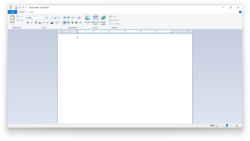WordPad
| Component of Microsoft Windows | |
 WordPad in Windows 11 | |
| File name/executable | wordpad.exe |
|---|---|
| Type | Word processor |
| Included in | Windows 95-Windows 11 23H2 |
| Replaces | |
| Write | |
WordPad is a word processor included as part of Microsoft Windows, being introduced in Windows 95.
History[edit | edit source]
Windows 95 and NT 4.0[edit | edit source]
WordPad made its first appearance in early Windows 95 builds where it was known as WritePad and was intended to replace Write. It was a word processor largely similar to Notepad in terms of user interface, and it kept the same purpose of working with text documents. However, WritePad could support more text functionality not present in Notepad, which could be managed from a small toolbar.
Later, in build 99, it was renamed to WordPad, which would become its final name.
WordPad also arrived to the NT family in NT 4.0 build 1234 as a separate component on the installation media, then as an integral part of the operating system in build 1264, replacing Write in the process.
Windows XP, CE family and Vista[edit | edit source]
Later versions of Windows didn't have many changes in WordPad until Windows 2000, where full Unicode support was added, enabling support for multiple languages. In addition, Tablet PC Edition 2005 jointly added speech recognition which has been expanded in Windows Vista to all computers.
On the other side, OEMs and vendors could also supply Windows CE installations with a similar word processor also called WordPad which had a similar functionality, but uses the icon present in Microsoft Word 95 and 97. It was included until Windows Embedded Compact 7.
Windows 7[edit | edit source]
WordPad's first and only major overhaul was seen in Windows 7 build 6608 and was hidden under the Bluepill mechanism. It included the replacement of the toolbar by the Ribbon, the redesign of most of the icons, and the replacement of the default font Arial with Calibri. In future builds, only minor design enhancements were made.
Windows 10[edit | edit source]
Windows 10's initial release had an untouched WordPad from 7. However, it was announced that it would be deprecated, and in version 2004 it was made an optional feature that could be uninstalled through Settings.
Deprecation[edit | edit source]
On 1 September 2023, Microsoft has announced that WordPad is no longer being updated and will eventually be removed in future releases of Windows.[1] Starting with Windows 11 build 26020, WordPad is not included in a clean installation of the operating system.[2]
Functionality[edit | edit source]
WordPad provides more advanced functionality than Notepad, which include the ability to format (bold, italic, centered), color, and print text. WordPad, however, lacks other key features from Microsoft Office's Word, like a spell checker, word count, thesaurus, or foot and endnotes. In addition, WordPad can work with many Rich Text Format features that can't be created on it such as indentation, text strikeout, super and subscripts, numbered lists, URL linking, and greater line spacings.
File type support[edit | edit source]
WordPad supports saving and opening documents in the following file formats in Windows 10 and 11:
- Rich Text Format (default) (
.RTF) - Standard Text Document (in normal, MS-DOS and Unicode format) (
.TXT) - Office Open XML Document (
.DOCX) - OpenDocument Text Document (
.ODT)
In addition, WordPad could open classic Word documents (.DOC) until Windows XP, as support for this format was removed in Windows Vista due to rendering and formatting issues, as well as a security vulnerability that was found. Microsoft recommended users to use the Word Viewer instead.
Write[edit | edit source]
Despite WordPad replacing Write as the built-in advanced word processor in Windows, it kept the original Write application, write.exe, in both the Windows and System32 folders as compatibility stubs that launch WordPad. In addition, when the app is uninstalled in Windows 10, the Write shortcuts are removed too.
Gallery[edit | edit source]
Windows 9x[edit | edit source]
WritePad in Windows 95 build 73f
WritePad in Windows 95 build 89e
WordPad in Windows 95 build 99
WordPad in Windows 98
Windows NT[edit | edit source]
WordPad in Windows XP
WordPad in Windows Vista
WordPad in Windows 7 build 6608
WordPad in Windows 7 build 6780
WordPad in Windows 7
WordPad in Windows 8
WordPad in Windows 10
Windows CE[edit | edit source]
WordPad in Windows CE 5.0
WordPad in Windows Embedded Compact 7
References[edit | edit source]
- ↑ Deprecated features for Windows client, Microsoft Learn.
- ↑ Official announcement, Windows Insider












